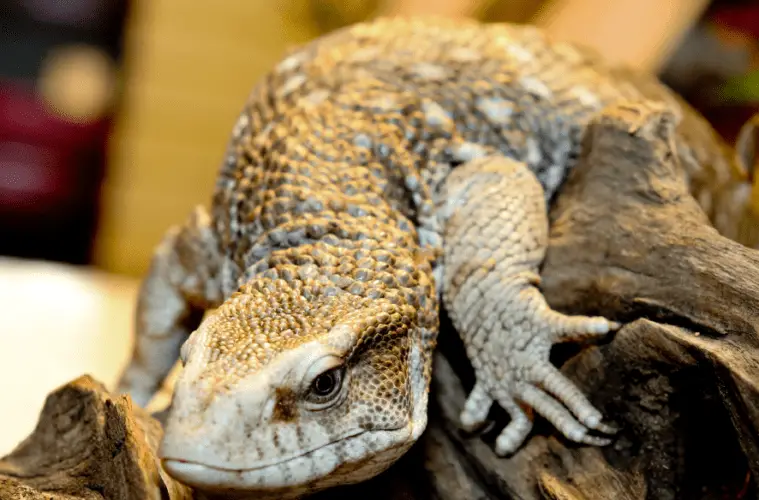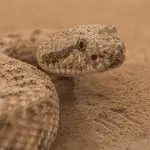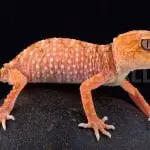Scientific Facts
| Common Name: | Savannah Monitor |
| Scientific Name: | Varanus exanthematicus |
| Life Span: | 15 to 20 years |
| Size: | From 4 inches (hatchlings) to 5 feet (adults) |
| Habitat: | Savannah, open forests, deserts, woodlands |
| Country of Origin: | Central South Africa |
Physical Description
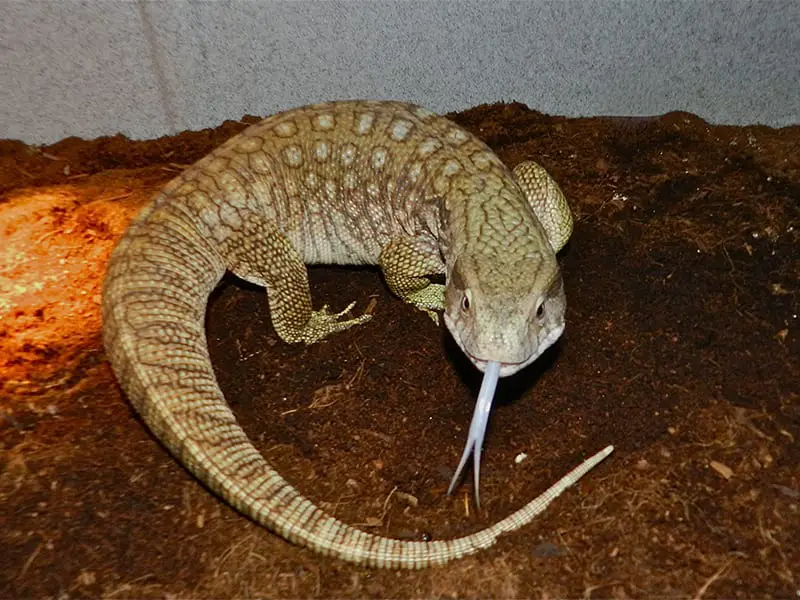
Savannah Monitor lizards are usually the bigger or larger types of pet lizards in the sense that they can grow up to 5 feet in length and can weigh up to 13 pounds. Most Savannah Monitors have body colors that can be yellowish to greyish but will mostly be near the yellow color spectrum. Adding to that are yellowish marks on the head. Meanwhile, what you can find all over their backs are asymmetrically arranged yellow circular marks that all have dark edges to separate one mark from another. It is not uncommon to see the same kind of marks on their tails.
The belly of a Savannah Monitor lizard usually varies from light yellow to light brown and is lined with asymmetrical dark brown pattern all the way to the tail area. While yellow and brown are usually the defining colors of a Savannah Monitor lizard, there are some that are greyish. It really depends on their habitat. Like most lizards, they have a forked tongue. However, a defining trait among Savannah Monitors is that their tongue is usually blue in color.
Savannah Monitor lizards are usually the stout type of lizards because of their docile nature. Aside from that, they do not have any other defining features aside from their size and color.
Aside from that, you can also tell apart males from females. The male Savannah Monitors tend to be larger compared to the females of the same age. Meanwhile, males have a more golden hue in terms of their yellow or brown coloration while females usually have a more dull color of brown. Also, male Savannah Monitor lizard snouts are more bulbous compared to females as they mature.
Lifespan
Savannah Monitor lizards usually have longer a longer lifespan compared to other pet lizard varieties. Savannah Monitors usually have an average lifespan of somewhere between 15 to 20 years although some people tend to have lizards that only reach 10 to 13 years of age due to poor handling and misinformation on the part of their owners. When taken care of properly, these lizards can potentially reach 20 years. Meanwhile, the ones that you see in the wild are expected to have a significantly lower lifespan compared to the ones grown and bred in captivity.
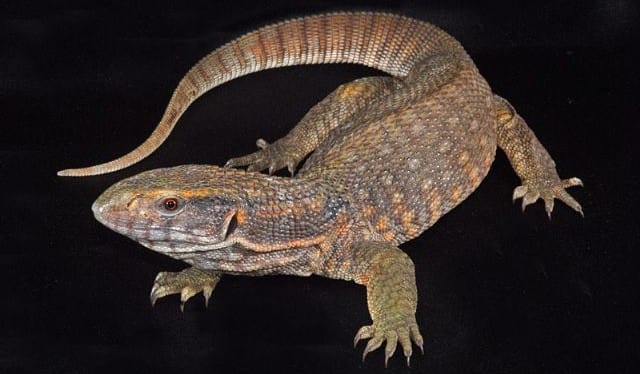
The three stages of growth of Savannah Monitors are as follows:
Hatchling
Savannah Monitor lizards tend to grow at a rapid pace during the first two months of their lives as hatchlings. This is where you will notice how quickly they will grow from being about a few inches long to about at least a foot long during their juvenile years.
Juvenile
The juvenile years of Savannah Monitors tend to be somewhere between six months to 18 months. During this stage, they will continue to grow but not at a rate as fast as when they were still hatchlings.
Adult
Savannah Monitor lizards can reach sexual maturity as early as 18 months to two years of age although there are those that need an extra year or two to reach their mature size. Mature Savannah Monitors can range from 2.5 to 5 feet in terms of the length although most are usually somewhere close to about 3 feet in length.
Eating Habits
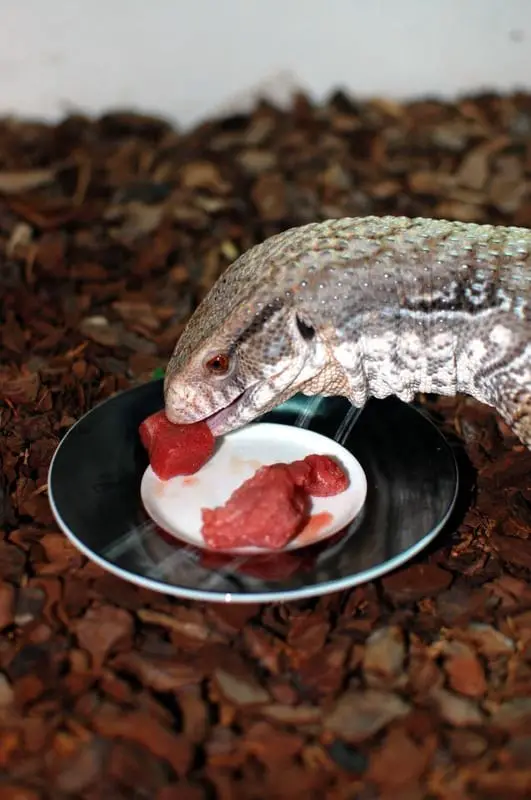
Nutrition and diet are the most essential part of keeping your Savannah Monitor lizards healthy. And if you want to make sure that you get to maximize their lifespan, it is important for you to make sure that they are getting the nutrients that are proper for these animals. Of course, like most other lizards, their diet usually depends on the stage of their life cycle they are in.
The younger and juvenile Savannah Monitors tend to prefer eating smaller insects and worms. It will not be uncommon to see your juvenile Savannah Monitor lizard searching for small prey such as roaches and mealworms. However, the one thing you should avoid is feeding them with mice since these rodents do not have the proper nutritional value that growing juvenile Savannah Monitors need. Moreover, these lizards were not made to digest large quantities of fat and fur. In that sense, it is best to keep them away from small rodents while they are still in the process of maturation.
During their adult years, Savannah Monitor lizards should still continue to feed on insects. However, it will not be rare for your lizard to be hunting for other prey such as birds and smaller reptiles. Mice or other rodents are reasonable parts of an adult Savannah Monitor’s diet but keep in mind that they were not meant to digest large quantities of fur and fat. As such, it should be better for you to limit their rodent diet to about two mice a week.
Adult Savannah Monitors love to eat large quantities of insects. As such, most pet owners tend to purchase colonies of roaches that can be an almost unlimited supply of food for their Savannah Monitors because these roaches tend to replenish their ranks rather quickly. You can even feed them with eggs from time to time but make sure to limit their egg intake because too much protein can lead to gout in adult Savannah Monitors.
Crickets are also ideal for Savannah Monitors because those bred in captivity tend to be docile and quite lethargic in nature. To make sure that your lizard does not get fat at a rapid pace, having them chase crickets around can provide them with good exercise.
If you want to take the commercial route, you can occasionally feed your young Savannah Monitors with high-quality canned dog food especially if your lizard is quite scrawny. The additional nutrients in the dog food will provide them with more than enough of what they need to grow strong and healthy. However, adult Savannah Monitors should only be fed with dog food whenever they are sick to avoid feeding them with a high-calorie diet.
Speaking of which, Savannah Monitors that are not in seasonal hibernation or breeding season will eat almost anything you feed them and usually do not know when to stop. As such, when you notice that your lizard does not willingly eat the food you offer, it is most likely ill. Make sure that your lizard gets the right nutrition because you should never leave a sick Savannah Monitor lacking in nutrition during hibernation or breeding season.
Sleeping Habits
Savannah Monitor lizards are usually lazy reptiles that seem to only move around when they are hunting for food. But since those bred in captivity have little need to hunt their food, it is very common for such lizards to be not as active as those who grew in the wild. That said, the younger Savannah Monitors tend to sleep all day. Some owners tend to worry a lot about how baby Savannah Monitors tend to sleep a lot. But as long as the lizard is eating and drinking properly, there is no reason to be too concerned.
Meanwhile, juveniles and adults are still very much lazy but are a bit more active than baby Savannah Monitors. To make sure they do not waste away their entire day sleeping, it might be a good idea to feed them with live crickets so that they will have a bit of exercise chasing their prey around.
Water
Savannah Monitor lizards come from dry and arid areas that do are not as abundant in water as other regions are. However, what is odd is that these reptiles tend to drink water regularly and do not thrive well when left without a lot of water. In the wild, it is common for Savannah Monitors to hide in moist burrows where they can protect themselves from the heat of the sun and from the dry outdoor climate that can lead to dehydration.
Those kept in captivity regularly soak themselves in the water when you provide them with a large dish of water. As such, to avoid wastage, it is best for you to use larger and heavier dishes that your Savannah Monitor will not easily tip over.
One problem with a large dish of water, however, is that your lizards will not only regularly soak themselves in it but will also defecate there. That means that you should always make sure to disinfect the dish and replace the water with a fresh new batch to avoid getting your Savannah Monitor ill from their own waste matter.
In all other cases, the important thing to note here is that the water dish should be large and always full of fresh clean water. You should also keep the dish in the coolest part of the enclosure to make sure that it stays cool enough for your Savannah Monitor to soak in when it feels hot and dry.
Development and Reproduction
Savannah Monitors tend to reach their sexual maturity as early as a year and a half to 2 years. As such, most lizards will be ready for reproduction at that age although it might be best to wait for them to reach at least 3 years of age to make sure.
Unlike most other monitor lizards, Savannah Monitors tend to be a bit more difficult to breed because of how they need certain facilities that make conditions suitable enough for them for breeding. As such, you should make sure to make things suitable for them first before you try to attempt to breed your monitor lizards.
An adult female monitor lizard tends to gain weight while their eggs develop. In that regard, make sure to feed them about three times a week. Provide them with a lot of nutrients they need for egg production. They would need calcium and vitamin D3 in that regard. The females should be at least 5.5 pounds during the breeding period. When they are ready to mate, females are extra receptive to male Savannah Lizards, who are very well aware of that fact. That means that mating can take as early as a day.
How to Breed
Mating season usually happens during the wet season when your Savannah Monitors are healthy and thriving. As mentioned, preparing your Savannah Monitors for breeding can be a pretty tricky endeavor because you have to make sure that the conditions are right for them to breed. You have to prepare the tools you need to induce breeding.
First off, having a big and spacious enclosure is vital to make sure to fit the pair. Fill the enclosure with a good mix of sand and soil to mimic the right conditions your Savannah Monitors often encounter in the wild.
Reduce the temperature of the enclosure to about 15 degrees Fahrenheit and make sure that you reduce the photoperiod. You can give them about a maximum of only 7 hours of light to try to induce breeding. You will notice that the male will be relentless to breed and will often follow the female while scratching his way. The female Savannah Monitor will eventually give in to the male’s advances.
Common Health Problems
While Savannah Monitors are reptiles that tend to be healthier than most other lizards and have a reasonably long lifespan, it is not uncommon for them to have health problems that not only come from poor handling and nutrition but also from environments that are not suitable for them to thrive in. As such, it is important for you to know such health problems so that you can give them a diet and an environment that will allow them to avoid serious health complications.
Weight gain
Savannah Monitor lizards tend to be docile and lazy creatures that do not like moving around or doing many activities other than sleeping or trying to escape their enclosure. What that means is that these reptiles are very susceptible to weight gain. That is why most Savannah Monitor lizards tend to be plump creatures that are heavier than most lizards of the same length.
In that sense, make sure to give your Savannah Monitor a reason to move around and be active. Also, one thing you should take note of is to keep their diet low in fat. Try to avoid feeding them rodents because of how mice are rich in fat but poor in other essential nutrients needed by Savannah Monitors.
Parasitic infections
Another problem that Savannah Monitors commonly face is a high risk of getting parasitic infections. Internal parasites get into their system through the food they eat. The most glaring symptoms of such are usually sluggishness and the lack of appetite. Vomiting is not rare as well when your Savannah Monitors are suffering from illnesses afflicted by internal parasites.
External parasites can also cause problems as well. Tics and mites can very well suck the blood out of the skin of Savannah Monitors kept in captivity. Such can cause serious health problems that can threaten the life of your reptile if you are not quick to act on it.
Respiratory infections
Respiratory infections are actually quite common in the lizard world. Whether the cause is bacterial or viral, symptoms include decreased appetite, bloating, open mouth breathing, or even wheezing when breathing.
In Savannah Monitors, respiratory infections can cause serious complications and may, in fact, become life-threatening especially when it already concerns massive weight loss due to decreased appetite and difficulty in breathing.
Preventing Illness
The moment you notice anything wrong with your Savannah Monitor lizards, the best thing to do is to bring them to a veterinarian right away. Make sure to choose your vet carefully because not all of them know how to handle monitor lizards or even reptiles. If you do not do so, improper treatment might cause more complications or even death. In that case, it is vital that you already have a list of vets that know how to treat reptiles.
Aside from that, one other thing you should do to make sure that your Savannah Monitors do not get ill is to change any environmental conditions. Correct the environment they live in and the food they eat to try to prevent them from getting ill. Most of the time, infections and parasites can simply arise from poor living conditions on the part of your Savannah Monitors. As such, make sure that their enclosure is as clean and as parasite-free as possible while also placing them in climate conditions that are suitable enough for Savannah Monitor lizards.
Behavior
Savannah Monitor lizards tend to be quite docile and lazy reptiles that do not do a lot of activities and are quite submissive to a much more dominant creature. However, these lizards tend to be the most active during the day when they are trying to burrow their way through the soil or the substrate or when they are trying to escape the enclosure. Other than that, most Savannah Monitors spend a lot of time doing nothing.
Here are some of the more common things that Savannah Monitor lizards have been observed to do quite a lot:
Burrowing
While Savannah Monitors may be native to the hot and dry climates of Africa, most breeders have found that they are more receptive when kept in a humid environment that allows them to burrow to find a means of shelter because these are quite secretive and shy reptiles that do not like being exposed. As such, it will not be uncommon for them to be spending so much time hiding underneath the substrate where they feel safer.
Hissing
Savannah Monitors usually hiss louder when they feel agitated or when they feel any sort of aggression coming from another party. Hissing is their way of showing dominance and as a means of warning, you to stay away from them. However, as docile as they are, Savannah Monitors do not usually follow up their hissing with aggression. Some owners are able to safely touch or carry their monitors after a loud hissing. But for safety purposes, it might be best to leave the lizards alone when they feel agitated.
Tail Whipping
Similar to hissing, tail whipping is a means for Savannah Monitors to show dominance over another species. These lizards have thick and long tails they can easily use as weapons against a potential threat or attacker. That means that any sort of aggression can lead a Savannah Monitor to try to tail whip you especially if it feels threatened by your presence.
Sneezing
A reason why it is important to keep your Savannah Monitor in a substrate that is quite humid is that these reptiles are prone to sneezing. As mentioned, these lizards love digging through the substrate. And if you place them in a substrate that is too try, this can easily irritate their nose when they are digging. As such, sneezing will not be an uncommon behavior for most Savannah Monitors.
Hibernation Cycle
Savannah Monitor lizards do not always go through a stage of hibernation because they are not used to living in areas that have cold falls and winters that will force them to hibernate. As such, one could say that hibernation in Savannah Monitors is seasonal in the sense that they will only do so as a response to a change in the season.
Those who live in regions where the fall and the winter seasons tend to get too cold will notice that their Savannah Monitors go through a seasonal hibernation. During that time, the reptiles will seem lazier than they already are in an attempt to save energy. Some might mistake this for a sort of illness but it really is just them going through a seasonal hibernation.
However, it is not advised that Savannah Monitors go through seasonal hibernation induced by cold falls or winters. Try to keep the temperatures in the enclosure at a consistent and suitable level to avoid seasonal hibernation. However, if it happens despite that, then it happens.
Shedding
Shedding is a common trait that reptiles share. In that regard, it is expected that Savannah Monitor lizards go through periods of shedding. Like most other reptiles, Savannah Monitors shed the most during their hatchling and juvenile stages when they are still in the middle of rapid growth. It is vital for them to shed their old skin that no longer fits their growing bodies.
Another reason why it is important to give your Savannah Monitor a good substrate that allows them to burrow is because of their shedding. In the wild, these reptiles often burrow through moist soil to make sure they stay hydrated as well as to make sure that they are shedding their skin healthily. The more hydrated they are, the more healthily they shed their skin.
Habitat
The habitat or the enclosure of your Savannah Monitor is arguably the most important part of taking care of this kind of a reptile because everything it needs aside from food stems from its habitat. So, if you want a happy, healthy, and thriving Savannah Monitor, make sure to give it the best habitat you can possibly give and one that fits the conditions needed for it to live a long and prosperous life.
Choosing a type of habitat or enclosure for your Savannah Monitor largely depends on your choice. A lot of people use large fish tanks or aquarium. Meanwhile, there are those who use terrariums as enclosures. You can even build your own terrarium if you want. If not, you can easily make a quick search to find establishments that sell enclosures that are fit for the type of habitat a Savanna Monitor needs.
Savannah Monitors are quite strong and are prone to escaping their enclosures. That means that it is important for your habitat to have a strong lid that could prevent these escape artists from climbing up. Also, when choosing a lid, it is also important to take note of airflow. Avoid using glass or other solid types of the lid to make sure that your lizard gets the much-needed air it needs for breathing and to feel cool.
After choosing a suitable enclosure to serve as a habitat for your Savannah Monitor, another thing that you need to consider are the different fixtures and equipment you need to make sure that it becomes an ideal place for your reptile to live in.
Lighting and Humidity
Like any other lizard, the Savannah Monitor requires a lot of ultraviolet B or UVB light to help it metabolize calcium. UVB is also a good source of light for your Savannah Monitors in terms of getting vitamin D3. A UVB light of about 8 to 10% should be your best bet here. Make sure that you give your reptile about 10 to 12 hours of light a day, which is similar to what they usually get in the wild. But for those who want to use light as their source of heat, then it might be best to use a mercury vapor bulb.
As previously mentioned, though Savannah Monitors are used to the dry climate of Africa, they prefer to stay hydrated instead of dry. In that case, it is best for you to monitor the humidity levels using a hygrometer. You may want to keep the soil humidity level somewhere over 60% as much as possible.
Temperature
Although Savannah Monitors prefer to keep themselves hydrated, these animals are used to the warm temperatures of Arica. In that case, try to mimic the desert-like conditions of the Savannah as much as possible by using a heating source such as light or a heating pad. You can also use other means of heating the enclosure. These can range from heat tapes, incandescent lamps, and other ceramic products to provide more heat.
Savannah Monitors prefer an environment that is at least 90 degrees Fahrenheit but probably not more than 110 degrees. Nighttime is essential because that is when heat usually drops to about 75 degrees. This is when it is vital for you to use heating pads. Also, it is important to note that you should always keep the temperatures at a suitable level so that your Savannah Monitor does not fall into a seasonal hibernation.
Sanitation
For the sake of sanitation, make sure that you clean out the enclosure as much as possible. Savannah Monitors are not necessarily messy lizards but you still need to clear the substrate out regularly to prevent them from getting parasitic infections. Cleaning the water dish is important since these reptiles regularly defecate in their water source.
Natural Environment – Substrate
Time and time again, we have mentioned that Savannah Monitors naturally love to dig through the ground to find shelter. As such, you should also mimic the conditions needed for these reptiles to be able to enjoy digging. It might be best for you to use a type of substrate that could encourage them to do so. There are those who use butcher paper because of how affordable it is. However, it might be better for you to use a mulch type of substrate to mimic the conditions they see in the wild as much as possible.
When furnishing the enclosure, try to avoid putting anything that is not necessary because your lizards will only push them around when they are moving. Avoid putting plants as well because most plants will not be able to survive the hot conditions in the enclosure.
Hydration
Savannah Monitors may be used to hot and dry conditions but these animals love to keep themselves hydrated. They will regularly drink water to keep their internal heat regulated. Meanwhile, it is not uncommon to see these reptiles submerging their entire bodies in water to keep their skin moist. That is why it is best for you to use a large water dish that will be able to accommodate their needs. It is vital to make sure the dish is solid enough to not easily tip over when the lizard is trying to hydrate itself.
Availability – Where to Get One?
It is not rare to see pet stores selling Savannah Monitor lizards especially when the store specializes in selling reptiles such as lizards and snakes. There are plenty of these stores in most localities but it should most likely be easier for you to grab one online. It might be best for you to go for those bred in captivity because their adjustment period to a captive state will be shorter compared to those caught in the wild.
How to Care for a Savannah Monitor?
Here are some tips on how to care for a Savannah Monitor:
- Savannah Monitors are some of the easiest reptiles to handle. They are not overly aggressive and quite docile. That said, those who want to care for Savannah Monitors will notice that they are easier to tame than other reptiles. But that does not mean that you should not handle them with utmost care.
- In their enclosure, what Savannah Monitors need the most are heat, lots of water, and a particularly deep substrate. If you can offer them those basic needs, you will most probably end up with a healthy reptile.
- Being cautious with the Savannah Monitor’s diet is an essential part of caring for these lizards because of how prone they are to obesity. They are not only lazy reptiles but are gluttons as well because they will eat almost anything that you offer them so long as it is a usual part of their regular diet.
FAQ Section
How big should Savannah Monitor enclosures be?
Savannah Monitors are large types of pet lizards that need a lot of space. That means that you may need to use an enclosure that is at least 5 to 6 inches long and wide and about 9 to 10 feet high. The height of the enclosure is meant to make sure that you can provide them with a deep enough substrate for them to dig through. Meanwhile, also make sure to leave about 3 to 4 feet from the surface of the substrate to prevent them from escaping.
Are Savannah Monitors good for beginner owners?
Because of their size and generally docile nature, Savannah Monitors are easier for beginner pet owners to handle compared to other types of lizards.
How often should you feed your Savannah Monitors?
This really depends. Growing Savannah Monitors at the early stages of their youth should be fed about three times a week. But when they reach adulthood, you may want to decrease it to once or twice a week because of how prone they are to obesity.
Can you feed Savannah Monitors with vegetables?
While Savannah Monitors may be carnivorous, it is okay to feed them vegetables from time to time to provide them with the essential vitamins they cannot get from eating insects and other types of meat.
How often do Savannah Monitors defecate?
It really depends on how often they eat and on how much you feed them. It is usually in line with how often they are eating.
Can you use light for heating Savannah Monitors during the night?
It really is not advised that you do so because Savannah Monitors also need a bit of darkness, especially at night. But if you want to maintain temperature levels during the nighttime, you may want to use a heating pad or other non-light-based sources of heat for your reptile.
Are Savannah Monitor lizard bites dangerous?
When agitated too much, Savannah Monitors will bite. However, their teeth are not meant for piercing but were meant for tearing and crushing. Their bites will be painful but will not do as much damage as a dog bite. Furthermore, they generally are not poisonous but Savannah Monitors bites carry a lot of bacteria that can be dangerous when the wound is not treated right away.
Is it okay for Savannah Monitors to be climbing around?
It is perfectly normal for Savannah Monitor lizards to be climbing around so much trying to escape their enclosures. Not only is it part of their daily activities but it also provides them a good exercise for their joints and limbs. Moreover, it also prevents their claws from growing too long because of all the scratching and clawing they will be doing when climbing.
How long can Savannah Monitors go without eating?
You may notice your Savannah Monitor refusing to eat during its first few weeks in captivity. However, you do not have to worry so much because these reptiles can go for a very long time without eating without a lot of negative effects on their health. Give them time to adjust and wait for them to start eating when they are ready. However, if they still refuse to eat after a long period of adjustment, you may need to bring the lizards to a vet in case they have fallen ill.
Do Savannah Monitors hibernate?
Yes, they do. However, their hibernation is seasonal in nature and is a response to a change in the temperature. That means that when the temperatures drop too low especially during the winter seasons, then your Savannah Monitor might go through a short seasonal hibernation. Since it is not advisable for your reptiles to go through such a period, make sure to keep the temperatures constantly high for them especially during the colder seasons such as fall or winter.
Is it okay to pet your Savannah Monitor?
Since Savannah Monitor lizards are quite docile or submissive to more dominant creatures, you can safely pet them. In that regard, they generally do not mind it when their owners pet them. However, if they feel a bit of aggression coming from your side, they might get too agitated and probably will not enjoy getting touched.

